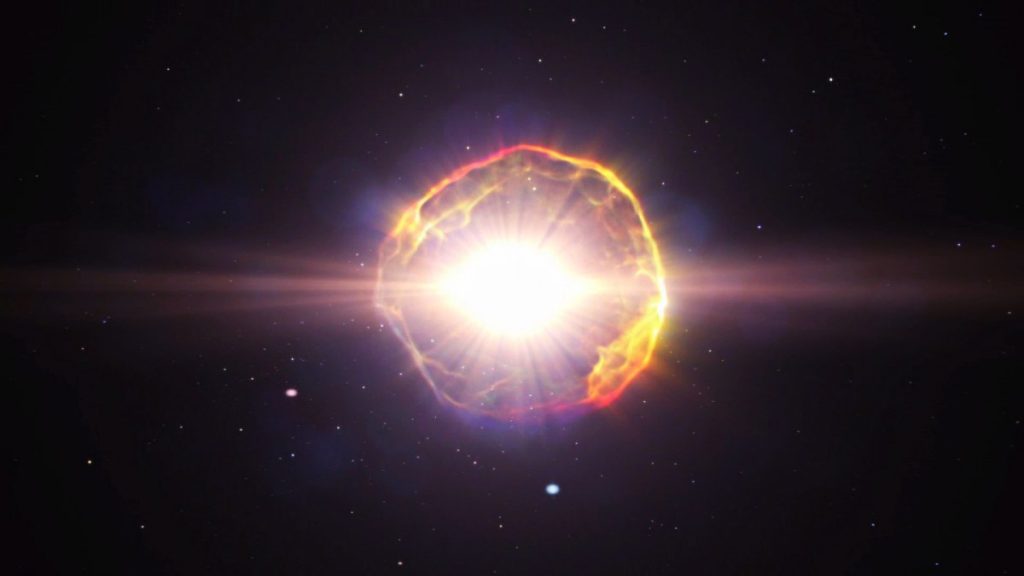
Huge, unusually powerful explosion in space just detected by scientists (Image Credit: Mashable)
In space, things frequently go boom.
And recently, on Oct. 9, astronomers observed an extraordinarily colossal boom. NASA’s Swift Observatory, which is specifically designed to spot the most powerful known explosions in the universe today — called gamma-ray bursts — detected an extremely strong such burst. Something wildly potent must produce these jets of energy that travel through space, and scientists say they’re caused by the collapse and explosion of enormous stars, events called supernovae.
For a star to go supernova, it must be quite massive — at least eight times the size of the sun. But for a supernova to produce the strongest type of gamma-ray burst, the star must be some 30 to 40 times the size of the sun. This new powerful detection, so rare that we’ll likely only observe something of this magnitude around once a decade, came from such a mighty star.
“It’s a very unique event,” Yvette Cendes, an astronomer and postdoctoral fellow at the Harvard-Smithsonian Center for Astrophysics, told Mashable.
Importantly, you need not worry. This terrific explosion happened in a galaxy 2 billion light-years away. At such a distance, its energy, which has been traveling and spreading through space for eons, poses no danger to us. But we can easily, with satellites, detect it.
“It’s the equivalent of getting front row seats at a fireworks show,” Cendes explained.
(Gamma rays are on the same radiation spectrum as the likes of AM and FM radio, visible light you can see, and x-rays, though gamma rays have the most energy.)
“This is incredibly, incredibly rare.”
Astronomers have never seen a gamma-ray burst in our galactic neighborhood (meaning the local galaxies around us). That’s because stellar explosions themselves aren’t too common. A star in our Milky Way galaxy will go supernova around once a century. But a huge star, the type that’s needed to make an extremely bright and long (on the order of several minutes) gamma-ray burst, only explodes about once every million years in a medium-sized galaxy like ours, noted Cendes.
“This is incredibly, incredibly rare,” said Cendes.
Gamma-ray bursts are detected far away because there are hundreds of billions of galaxies out in the deep cosmos, teeming with stars. There are relatively few opportunities for such an event to happen near us, compared to the wider universe. (What’s more, to detect it you have to be facing the direction of the “funnel” of energy radiated into space by the blast.)

Credit: NASA / ESA /. M. Kornmesser
Because these gamma-ray bursts often happen many billions of light-years away, the instruments built to detect these signals are extremely sensitive. That’s another reason this detection, which was relatively “close,” was so intense and “bright.”
“It’s like pointing a telescope at the sun,” Cendes explained. “It saturated the detectors.” The blast “ranks among the most luminous events known,” noted NASA.
You might wonder what now happens to the exploded star after such a dramatic collapse and explosion. It likely transformed into a black hole. “Most black holes form from the remnants of a large star that dies in a supernova explosion,” notes NASA.
Want more science and tech news delivered straight to your inbox? Sign up for Mashable’s Top Stories newsletter today.

Credit: NASA / Swift / A. Beardmore (University of Leicester)
Black holes are incredibly curious cosmic objects. As Mashable previously reported, black holes are places where matter has been crunched down into an intensely compact area. If Earth was (hypothetically) crushed into a black hole, it would be under an inch across. Yet the object would still be extremely massive, as it would contain the entirety of our planet’s mass. This results in a place with a gravitational pull so strong, not even light can escape. (Things with more mass have stronger gravitational pulls.)
Astronomers like Cendes are now watching the aftermath of the dramatic gamma-ray burst using powerful telescopes, like the Submillimeter Array radio telescope atop Mauna Kea, in Hawaii.
So the universe rolls on. A star dies. A black hole is born. And intelligent life some 2 billion light-years away detects it all happening.





